Iran’s President and Foreign Minister Killed in Helicopter Crash
A shocking development amidst regional turmoil.
AP (“Iran’s president, foreign minister and others found dead at helicopter crash site“):
Iranian President Ebrahim Raisi, the country’s foreign minister and several other officials were found dead on Monday, hours after their helicopter crashed in a foggy, mountainous region of the country’s northwest, state media reported.
The crash comes as the Middle East remains unsettled by the Israel-Hamas war, during which Raisi, who was 63, under Supreme Leader Ayatollah Ali Khamenei launched an unprecedented drone-and-missile attack on Israel just last month.
Khamenei announced Monday that Iran’s first vice president, Mohammad Mokhber, would serve as the country’s acting president until elections are held.
During Raisi’s term in office, Iran enriched uranium closer than ever to weapons-grade levels, further escalating tensions with the West as Tehran also supplied bomb-carrying drones to Russia for its war in Ukraine and armed militia groups across the region.
Meanwhile, Iran has faced years of mass protests against its Shiite theocracy over the ailing economy and women’s rights — making the moment that much more sensitive for Tehran and the future of the country.
Among the dead was Iranian Foreign Minister Hossein Amirabdollahian, 60. The helicopter also carried the governor of Iran’s East Azerbaijan province, a senior cleric from Tabriz, three crew members and a Revolutionary Guard official, the state-run IRNA news agency reported. IRNA said the crash killed eight people in all, including three crew members, aboard the Bell helicopter, which Iran purchased in the early 2000s.
Aircraft in Iran face a shortage of parts, often flying without safety checks against the backdrop of Western sanctions. Because of that, former Iranian Foreign Minister Mohammad Javad Zarif sought to blame the United States for the crash in an interview Monday..
“One of the main culprits of yesterday’s tragedy is the United States, which … embargoed the sale of aircraft and aviation parts to Iran and does not allow the people of Iran to enjoy good aviation facilities,” Zarif said. “These will be recorded in the list of US crimes against the Iranian people.”
A NYT report (“Helicopter Carrying Iran’s President Has Crashed, State Media Reports“) written before the deaths were confirmed notes:
If the president dies, the vice president takes over and elections must be organized within 50 days, said Ali Vaez, the Iran director of the International Crisis Group, an independent conflict prevention agency.
That, he said, would be “a major challenge for a country that is in the midst of a severe crisis of legitimacy at home and daggers drawn with Israel and the United States in the region.”
Mr. Raisi is a hard-line religious cleric who came of age during the country’s Islamic revolution. Under Iran’s theocratic system, Mr. Raisi, as president, is the second most powerful individual in Iran’s political structure after the supreme leader, Mr. Khamenei.
After becoming president in 2021, Mr. Raisi consolidated power and marginalized reformists who wanted to defuse tensions with the West. He repeatedly said that he pursued a policy of “strong diplomacy,” forging closer economic and security ties with Russia and China.
During Mr. Raisi’s tenure, Iran continued to expand its regional influence, backing proxies across the Middle East that have conducted strikes against Israel and the United States, as well as advancing the country’s nuclear program.
In the same period, Mr. Raisi oversaw a sweeping and deadly crackdown on domestic protesters, many of them women and young people, who had taken to the streets against the country’s ruling clerics. Rights groups said hundreds of protesters were killed by the nation’s security forces.
Mr. Raisi has been viewed as one of the front-runners to succeed Mr. Khamenei as supreme leader. One of his main rivals for that role is a son of Mr. Khamenei.
Despite the crash, some analysts said they did not expect a major change in Iran’s agenda abroad.
The nation’s supreme leader is responsible for setting all of the country’s policies, analysts said, while the president’s power comes from enacting those decisions.
Lyse Doucet, chief international correspondent for BBC (“Iran, despite this tragedy, will move on“) observes,
President Raisi was not the most powerful person in Iran, and was not the most powerful president in Iranian history. He was widely viewed as one of the weakest, elected in 2021 with a record low turnout and the exclusion of all moderate and reformist rivals by the overseeing body controlled by conservatives.
He was a middle-ranking cleric, a leading conservative, a hardliner who showed unconditional loyalty to the Supreme Leader Ayatollah Khamenei who is the ultimate authority in the Islamic Republic of Iran. Those are some of the reasons why Raisi was widely seen as a possible contender for the top job .
Naturally, there is speculation of foul play.
The Economist (“The death of Iran’s president will spark a high-stakes power struggle“) adds,
The official story so far is bad weather. It was rainy and foggy during the flight, with visibility said to be of just a few metres. Conditions were bad enough that rescue workers could not fly in to look for the president, and even drones could not find the crash site; the Red Crescent resorted to sending search teams on foot. Mother Nature could well be the culprit. Nothing is ever as it seems in Iranian politics, though, and many Iranians have begun to speculate about more nefarious explanations. Mr Raisi has a long list of internal enemies, from the relative moderates he has marginalised to the fellow conservatives who think he has been an inept president. It is not unreasonable to wonder if domestic foes conspired to kill him.
Unsurprisingly, some Iranians have also wondered if Israel had a role in the crash. The two longtime foes came to blows last month, after Israel assassinated an Iranian general in Damascus and Iran retaliated with a volley of more than 300 missiles and drones aimed at Israel. The Mossad, Israel’s spy service, has a long history of assassinating its enemies, including in Iran, where it has killed prominent nuclear scientists. But there are strong reasons to doubt Israel’s involvement. It has never gone so far as to assassinate a head of state, an unequivocal act of war that would invite a fierce Iranian response. It would be foolish to risk such consequences to kill Mr Raisi, a deeply unpopular politician who does not actually have the final say in many of Iran’s most important policy decisions.
Few Iranians will mourn him. They will remember him as the “hanging judge”, a prosecutor in Tehran who helped send thousands of political prisoners to the gallows in 1988. And they will remember his clueless handling of the economy—the president who stocked his cabinet with military men and clerics who watched as the rial lost 55% of its value in less than three years.
BBC Middle East Correspondent Lucy Williamson reports there is “No whiff of Israeli involvement so far.“
Iran’s state media has instead focused on bad weather as the cause of the helicopter crash.
And Israeli officials are privately briefing local news outlets that the country had no hand in the Iranian president’s demise.
It’s only a month since the long shadow war between the two nations burst into the open, after Iran launched hundreds of drones and missiles towards targets in Israel.
Since then, an uneasy status quo has been restored, but both that confrontation and the war between Israel and Iran’s proxies in Gaza and Lebanon have put the region under pressure.
While the camp of the younger Khameini would be the more obvious candidate, I strongly suspect that the crash was indeed weather-related. Helicopters are notoriously dangerous and the combination of mountains, rain, and heavy fog is not a good one.
BBC International Editor Jeffrey Bowen (“Years of sanctions have left Iranian aircraft unsafe – as I know too well“) lends credence to Western sanctions playing a role.
The Iranian media has not been suggesting that there has been foul play, only that the weather was so terrible and there was this crash.
However, President Raisi had many enemies, and there will be plenty of people who will be very happy that he’s dead.
Back in the 80s, he effectively signed the death warrants for thousands of dissidents who were mainly leftists.
He’s been president since 2021 and during his tenure he’s been involved in massive crackdowns against people inside Iran. Plus, he was tipped to get the top job and that’s one good way of getting a rival out of the way. But we have no evidence for all of this.
In Iran, there’s always a reflex that you blame Israel. Israeli officials have been saying to Israeli journalists, they’re not involved in it. It is hard to see why Israel would benefit from what would effectively be a very provocative act of war.
As for bad weather, the fact is, is that because of years and years of sanctions, Iranian aircraft are pretty unsafe because they can’t get spare parts or new airframes.
Back in 1990 when I was reporting on a very big earthquake in Iran, not far from where Raisi was killed, I was in an American helicopter, from the era of the Shah, which had to make a forced landing because one of the engines failed from poor maintenance.
A few weeks later, I was told that aircraft actually crashed killing everybody on board.
It is noteworthy that, while public expressions of condolences have poured forth from the region, Russia, and China, the United States and Europe have been silent, with the exception of EU Council President Charles Michel.
UPDATE: Clemson University Iran scholar Arash Azizi, writing in The Atlantic before the deaths were confirmed, asks “Who Would Benefit From Ebrahim Raisi’s Death?“
Iran doesn’t seem like a country in which presidents die by accident. But it also is a country in which aircraft crash, due to the sorry state of infrastructure in the internationally isolated Islamic Republic. In previous years, at least two cabinet ministers and two leading military commanders have died in similar crashes. Raisi’s chopper, which also carried Iran’s foreign minister and two top regional officials, was passing through an infamously foggy and mountainous area in northwestern Iran. The “incident” might very well have been an accident.
Yet suspicions will inevitably surround the crash. After all, air incidents that killed high political officials in Northern Rhodesia (1961), China (1971), Pakistan (1988), and Poland (2010) are still often subject to speculation. In this case, much as in the others, one question will likely drive the speculation: Who stands to benefit politically from Raisi’s death? Even if the answer to this question does not ultimately tell us why the helicopter crashed, it could shed some light on what will come next in the Islamic Republic.
Raisi ascended to the presidency in 2021, in what appeared to be the least competitive election Iran had held since 1997. Supreme Leader Ayatollah Ali Khamenei had made sure that all other serious candidates were barred from running. Among those disqualified were not only reformists but also centrist conservatives and even Mahmoud Ahmadinejad, a former hard-line president whom Khamenei came to see as a rival.
Raisi appeared to have been picked precisely because he could never be a serious rival to Khamenei. In 2017, he revealed himself to be utterly uncharismatic in electoral debates against then-President Hassan Rouhani. His time in office since 2021 also speaks not only to his sheer incompetence but also to his political irrelevance. Some call him the Invisible President. During the Women, Life, Freedom movement, which rocked Iran from 2022 to 2023, few protesters bothered to shout slogans against Raisi, because they knew that real power rested elsewhere.
For Khamenei, what mattered was that Raisi could be counted on to toe the regime’s line. Although competition is tight, Raisi may have more blood on his hands than any other living official of the Islamic Republic. Since the 1980s, the Islamic Republic has executed thousands of Iranian dissidents. The judiciary is the arm of the government that carries out this murderous function, and Raisi has held leading positions within it from the very start; he rose to become the head of the judiciary in 2019.
The same qualities that likely made Raisi seem like a safe regime choice for the presidency also made him a primary contender for succeeding Khamenei as the Supreme Leader. According to the Iranian constitution, only a cleric with serious political experience can become head of state. By now, many clerics who fit that description have died or been politically marginalized (many of them did not share Khamenei’s hard-line politics), leaving the field open to Raisi. In turn, many political observers expected that Raisi would be a weak supreme leader, allowing real power to flow elsewhere—to the Islamic Revolutionary Guard Corps (IRGC), for example, or to other power centers around or ancillary to the regime. Who better for such a position than an unimpressive yes-man?
[…]
Raisi’s death would alter the balance of power among factions within the Islamic Republic. According to the Iranian constitution, his vice president, Mohammad Mokhber, would assume the duties of the presidency, and a council consisting of Mokhber, Qalibaf, and the judiciary chief Gholam Hossein Mohseni-Eje’i would have to organize new elections within 50 days.
When I asked an official close to Qalibaf about the political aftermath of the crash, he answered immediately: “Dr. Qalibaf will be the new president.”
He surely would like to be. Qalibaf’s ambition is news to no one; he has run for president several times, starting in 2005. More technocrat than ideologue, Qalibaf was a commander in the IRGC during the Iran-Iraq War and will likely command at least some support from within its ranks. His long tenure as mayor of Tehran (2005–2017) was marked by both a degree of competence and quite a bit of corruption. His political enemies have recently highlighted cases of corruption linked to him and his family. An official close to former President Rouhani tells me, “Qalibaf’s problem is that he wants it too much. Everyone knows he has zero principles and will do anything for power.”
[…]
What twists the plot is the fact that some regime officials and former officials who are supportive of Qalibaf also advocate for Khamenei’s son Mojtaba to succeed his father as the supreme leader. Mojtaba Khamenei has long been in the shadows, and little is known about the 54-year-old’s politics or views, but he is widely held to be a serious contender for the office. Could there be a bargain between Mojtaba and Qalibaf that paves a path to power for both of them?
When the Islamic Republic’s founding leader, Ayatollah Ruhollah Khomeini, died, in 1989, Khamenei replaced him after making an unwritten pact with fellow cleric Akbar Hashemi Rafsanjani, who then assumed the presidency. The constitution was swiftly changed to give more powers to the president. Rafsanjani would come to regret the pact, as he was politically sidelined by Khamenei before dying what many in Iran consider a suspicious death, in 2017. Could this cautionary tale make both sides wary?
Many have anticipated a ferocious power struggle in Iran, but most expected it to follow Khamenei’s death. Now we are likely to see at least a dress rehearsal in which various factions will brandish their strength. As for the people of Iran, some have already started celebrating Raisi’s potential demise with fireworks in Tehran. Most Iranians barely feel represented by any faction of the Islamic Republic, and some might use a moment of political crisis to reignite the street protests that have repeatedly beleaguered the regime in the past. The country’s civic movements are exhausted following years of struggle (more than 500 people were killed in the most recent round of protests, from 2022 to 2023). Still, whatever shape the power struggle takes at the top, the people of Iran won’t receive it passively for long.

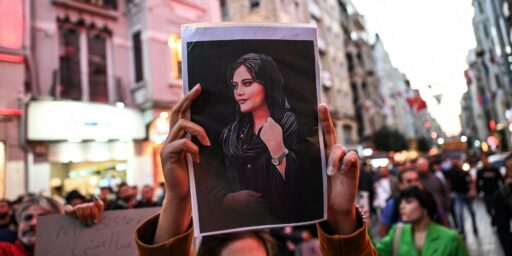
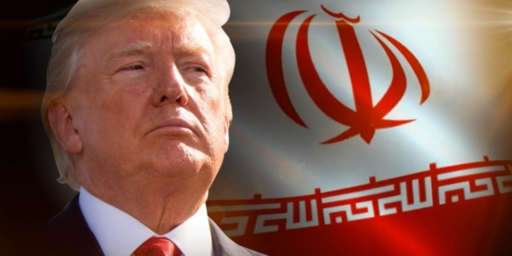
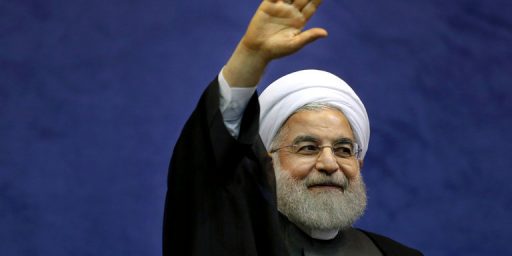
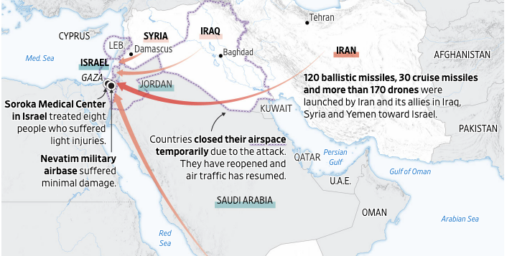
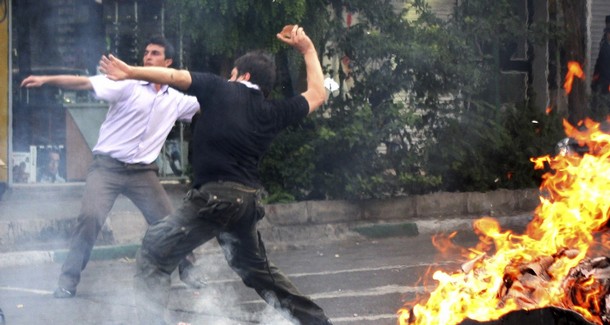
My sense is that in the end he was just an errand boy, taking orders from Khamenei. It was good when Czech and Slovak partisans killed Reinhardt Heydrich, like Raisi, he needed killin’. But the real enemy survives.
There are some jubilant reactions inside Iran
Thoughts and prayers.
May be the only air crash in which people are worried that someone might have survived.
It’s frankly silly to blame this on US sanctions. There is zero evidence of any kind of mechanical fault and all kinds of other reasons that idea is sophistry.
The most obvious cause is controlled flight into terrain. This is more like Kobe Bryant than anything conspiratorial nonsense – you combine helicopters, which are inherently dangerous, with powerful people that can overwhelm good judgment – then people often die.
@dazedandconfused:
I laughed out loud when I read that.
@Andy:
And yet former former Iranian foreign minister Zarif stoutly maintains that it was U.S. sanctions that caused the crash.
@CSK: To be fair though, Zarif gets paid to stoutly maintain that US sanctions are the cause. It’s his job, just as it’s Blinken’s job to dismiss any such claims. We’ll know what happened when/if a third party–with no “skin in the game”–reveals its report. From that standpoint, even if Bell Helicopter is invited to participate, the report may have biases that readers will need to evaluate. Hard to know what happened without being there–and those people are not going to talk, ever, sadly.
Helicopters are not inherently dangerous. But those who fly them know full well Thetis did not hold Achilles by the heel, but by the tail rotor. It’s too easily damaged. And if it’s damaged, the craft starts spinning on its axis and won’t stop while the main rotor turns (models with two main rotors don’t need a tail rotor to counter the spin).
The other weakness is they fly low and in urban environments. Power lines in particular are a major hazard.
They’re also used in hazardous situations. like flying too close to mountains or in bad weather to rescue people.
So I suppose they have accidents more often.
@Andy:
I agree in general but Kobe’s wasn’t CFIT, it was complete loss of control of the aircraft by the pilot. This may seem impossible for a professional pilot but instrument flying is the polar opposite from riding a bicycle: You practice or the skilz fade away. This is not a problem for jets and commercial operators of fixed wing, you are in clouds regularly and are always in the parts of the ATC “system” devoted to instrument flying. But helicopters, by nature of their ops, very seldom are. And helicopters are significantly more difficult to fly by instruments than fixed wing craft are.
It’s common to find pilots certified for instrument flying in helicopters who haven’t actually done it for years. Kobe’s guy was one such.
He was a mass murderer going back to 1985. Like Stalin’s death, this is a very good thing for regular citizens.